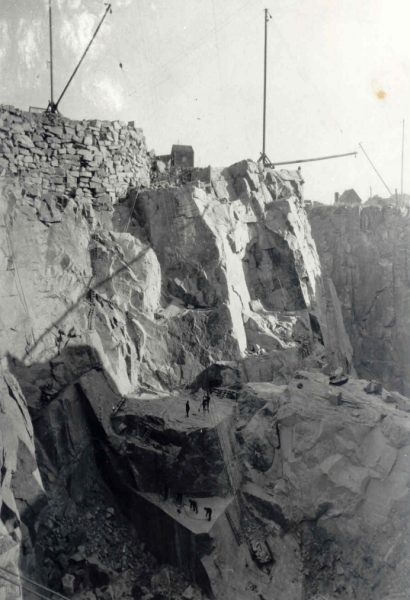Updated August 10 at 9:30 pm: Due to the high probability of rain on our original date, August 11, we have postponed this to August 18 at the same time. If you already have a ticket, there is no need to register again or notify me. We’ll look forward to seeing you on the 18th. If you have a conflict on the 18th, please go into Eventbrite and cancel your registration. — Lee Wright
Our walking tour with will be led by Tom Bonomi, historian at the Quincy Quarry and Granite Workers Museum. Please bring suitable shoes for hiking.
At the end of the walk we may go to lunch at The Tavern or Crossing Nines at Granite Links and then tour the small museum at the Lyons Turning Mill site. If you wish to skip lunch and go directly there that’s fine, too.
There is no cost for the tour, but the museum will gladly accept any donations you wish to make.
If the weather is questionable or worse, we may postpone this to the following Saturday. I will update this note as soon as that decision is made, so if you have a question the day before or that morning, check back here.
Updated August 10 at 9:30 pm: As noted above, we have postponed this to August 18 due to the high probability of rain when we were originally scheduled to tour the quarry.
The history of the quarries
From a publication that the company put out in 1926, The Quarries of the Granite Railway Company, The First Railway in America:
“The Granite Railway Company wishes to call to the attention of architects and others the preeminent qualities of dark Quincy granite which make it a most desirable building material. For more than one hundred years the quarries of the Granite Railway Company have been in continuous operation, and for the first fifty years of that period the principal use of the stone quarried was for buildings. Gradually the enduring characteristics of the stone and the increasing cost of labor led to its use almost exclusively in monumental work. With the advent of steel frame buildings and the development of improved methods in granite manufacture, the desirability of this particular stone for certain architectural purposes has again become recognized.

In 1826 the Granite Railway Company was organized under the guiding hand of Colonel Thomas Handasyd Perkins and chattered by the Commonwealth of Massachusetts for the dual purpose of quarrying stone and transporting it by railroad to the Neponset River, whence it was taken by vessels to all parts of the Atlantic coast from Maine to Louisiana. The railroad which it built in 1826 was “THE FIRST RAILROAD IN AMERICA”
For half a century the company operated both its quarries and its railroad, then it gave up its railroad and devoted its entire energies to the quarrying side of the business, relying for its transportation on the great network of railroads teaching to all parts of the United States. From the quarries of the Granite Railway Company came the stone for many notable buildings. Bunker Hill Monument was built of stone from its Bunker Hill Quarry. The Boston Custom House, converted into Boston’s loftiest building by the addition of a tower which serves as a landmark for many miles around, was built of stone from its Pine Hill Quarry. From the same quarry came the stone for Minot’s Ledge Light, one of the famous light houses of the world, rising from the water near the entrance to Boston Harbor at one of the most dangerous points on the New England coast.”
Text: Copyright 1928 by the Granite Railway Company. Compiled, arranged and printed by direction of Walton Advertising & Printing Company, Boston, Mass. Photo: DCR brochure.
For additional reading:
- DCR brochure, with map
- The Granite Railway, from the Quincy Historical Society (1991)
- Photographs showing the quarry, railroad, and the process of mining granite, from the Thomas Crane Public Library in Quincy
When
August 11 at 10 a.m. and lasting one and half to two hours.
If the weather is questionable or worse, we may postpone this to the following Saturday. I will update the note at the top of this page as soon as that decision is made, so if you have a question the day before or that morning, check there.
Where

The Quincy Quarries Historic Site
Getting there on the MBTA
Red Line to Quincy Center, take MBTA bus #215 to Copeland and Willard Streets, turn left on Willard, cross under the Expressway and take the first right onto Ricciuti Drive. The Quarries are ¼ mile on the right.
By car from the south: Take Route 93 to Furnace Brook Parkway (Exit 8) follow signs to Willard Street and cross under Route 93. Take the first right onto Ricciuti Drive at the UPS store and the large “Quarry Hills” sign. The Quarries are ¼ mile on the right.
By car from the north: Take Route 93 to Furnace Brook Parkway (Exit 8) turn right on Ricciuti Drive, between UPS and the large “Quarry Hills” sign. The Quarries are ¼ mile on the right.
Registration
Registration is required. A donation to the museum will be greatly appreciated by the volunteers who are giving us the tour today.


